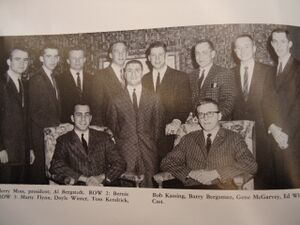The Indiana University Board of Aeons Bathroom Entrapment Scandal
Bathroom Entrapment Scandal
“Surveillance” is not just a metaphor to describe the paranoid feelings of the Cold War years. Between 1955 and 1959, an elite student council at IU known as the Board of Aeons became concerned with homosexuality on campus. Their actions were in line with activities on other campuses across the country, and in the federal government, where a policy of rooting out suspected homosexuals created what historians have come to call the Cold War “Pink Scare” or “Lavender Scare.”
The Board of Aeons was established in 1921 and consisted of twelve
undergraduate men chosen on the basis of their leadership and scholarship by the university president, to whom they reported directly. Their responsibility was to act as a bridge between the university administration and the student body. During the late 1950’s, the Board of Aeons was under the direction of President Herman B Wells, and they occasionally discussed specific instances of suspected homosexual activity on campus. For example, in a meeting on September 19, 1957, Aeon Bill Cast told the Board he had reason to believe that a professor, Leland S. McClung, was a "possible homosexual." The Board of Aeons tasked Cast with further investigating Professor McClung’s sexual behavior.
Planning
For a handful of students and faculty at Indiana University, the Board of Aeon’s attention to homosexuality did not end in idle speculation. On September 18, 1958, Board member Barclay Cale reported “possible homosexual activities in the men’s restroom on the second floor of the main library.” He suspected that men were soliciting other men for sex by leaving messages on the bathroom walls. After the meeting, Cale began observing usage patterns of the restroom, and later reported seeing several men spending extended periods of time in the restroom. The Board of Aeons then decided that all its members would take turns conducting a stake-out of the bathroom, with the goal of entrapping men caught engaging in sexual activity. They planned to refer first-time offenders for psychiatric treatment, and to expel repeat offenders.
Execution
On October 16th, 1958, Cale decided to use cameras to document homosexual activity in the bathroom, and to turn any evidence over to the IU Police Department. On October 23rd, he and another board member constructed a trap door in the restroom ceiling, behind which they installed the camera, and they tested their system for taking photographs of men using the toilet stalls. Afterwards, they began taking pictures of men—staff, students, and faculty—who they believed to be engaging in sex. At a subsequent board meeting, another Aeon claimed that the pictures were being spread around campus.
Aftermath
On November 6th, Dean of Students Robert Shaffer and Dr. Wardell Pomeroy of the Kinsey Institute attended a Board of Aeons meeting to help sort out the “homosexuality problem on the campus.” The Dean decided that all staff involved in the bathroom sex scandal would be immediately fired, but the students involved would be dealt with on an individual basis. The Dean also decided that the bathroom would be locked to everybody except staff members with keys.
It appears that the bathroom observation ended at the end of 1959, possibly because previous members of the Board urged the current members to keep their activities more positive. Rumors immediately following the event noted the departure of several students and at least one staff member soon after the conclusion of Clay’s bathroom entrapment scheme.
Sources Minutes of Meetings, Board of Aeons, 19 September 1957-11 December 1959. University Archives, Indiana University.
Navigation | Home | Before Stonewall | Stonewall to AIDS: the 70s |
AIDS and Community Life: the 80s | The Queer Decade: the 90s | Queer Here and Now: 2001-Present
<comments />
